Customer Satisfaction: Analysis of Research Articles Report
VerifiedAdded on 2023/06/08
|8
|1877
|244
Report
AI Summary
This report provides a structured abstract of a literature review on customer satisfaction, focusing on the American Customer Satisfaction Index (ACSI) model and its application across various research studies. The report examines four academic articles, including one that introduced the theory and three more recent articles employing quantitative, qualitative, and mixed-method research designs. It summarizes the theory's development, identifies common and different themes and findings, and discusses study limitations inherent in different methodologies. The analysis highlights the correlation between customer satisfaction, loyalty, and organizational performance, as indicated by the ACSI model. The report also discusses the practical implications of customer satisfaction research, with particular emphasis on how different research methods yield diverse insights into customer behavior and experience. The limitations of the studies, such as small sample sizes, are also considered. The report concludes by identifying areas for future research, including studies that can expand upon the current findings and explore the application of the ACSI model across different contexts and industries. The report also identifies the importance of the different research methods used in the studies, and the benefits of using a mixed methods approach. This report is designed to help students understand the theoretical concept of customer satisfaction, and the ways it can be measured and improved.
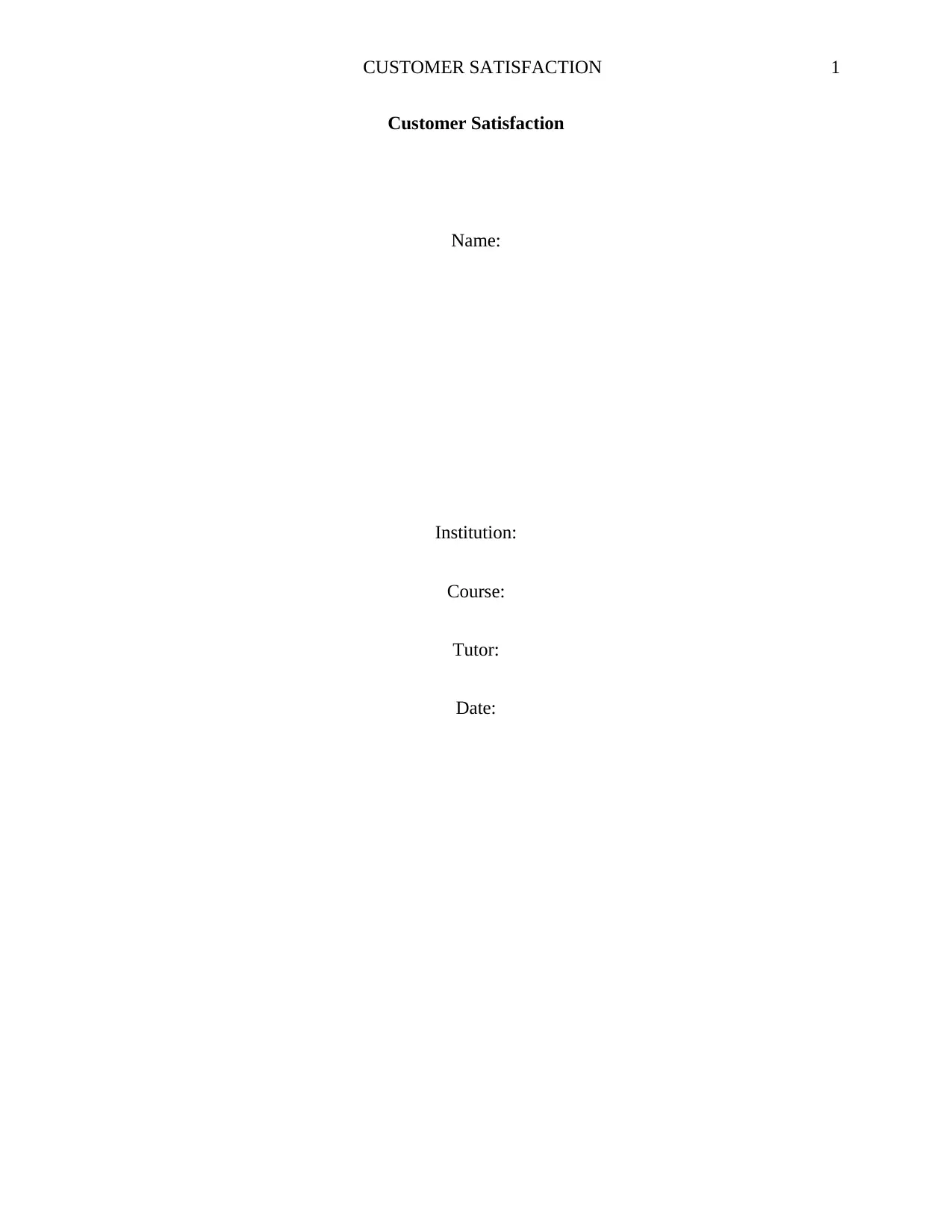
CUSTOMER SATISFACTION 1
Customer Satisfaction
Name:
Institution:
Course:
Tutor:
Date:
Customer Satisfaction
Name:
Institution:
Course:
Tutor:
Date:
Paraphrase This Document
Need a fresh take? Get an instant paraphrase of this document with our AI Paraphraser
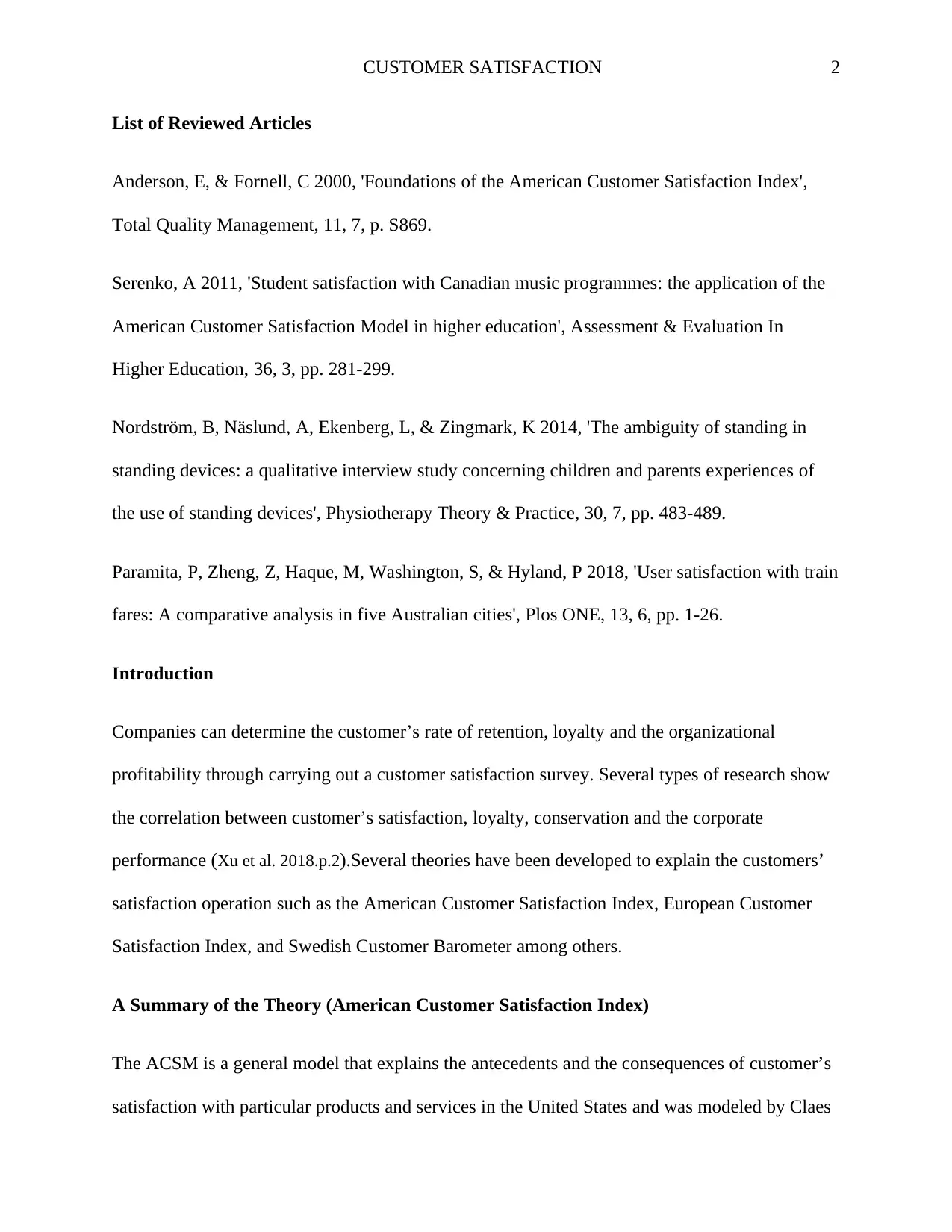
CUSTOMER SATISFACTION 2
List of Reviewed Articles
Anderson, E, & Fornell, C 2000, 'Foundations of the American Customer Satisfaction Index',
Total Quality Management, 11, 7, p. S869.
Serenko, A 2011, 'Student satisfaction with Canadian music programmes: the application of the
American Customer Satisfaction Model in higher education', Assessment & Evaluation In
Higher Education, 36, 3, pp. 281-299.
Nordström, B, Näslund, A, Ekenberg, L, & Zingmark, K 2014, 'The ambiguity of standing in
standing devices: a qualitative interview study concerning children and parents experiences of
the use of standing devices', Physiotherapy Theory & Practice, 30, 7, pp. 483-489.
Paramita, P, Zheng, Z, Haque, M, Washington, S, & Hyland, P 2018, 'User satisfaction with train
fares: A comparative analysis in five Australian cities', Plos ONE, 13, 6, pp. 1-26.
Introduction
Companies can determine the customer’s rate of retention, loyalty and the organizational
profitability through carrying out a customer satisfaction survey. Several types of research show
the correlation between customer’s satisfaction, loyalty, conservation and the corporate
performance (Xu et al. 2018.p.2).Several theories have been developed to explain the customers’
satisfaction operation such as the American Customer Satisfaction Index, European Customer
Satisfaction Index, and Swedish Customer Barometer among others.
A Summary of the Theory (American Customer Satisfaction Index)
The ACSM is a general model that explains the antecedents and the consequences of customer’s
satisfaction with particular products and services in the United States and was modeled by Claes
List of Reviewed Articles
Anderson, E, & Fornell, C 2000, 'Foundations of the American Customer Satisfaction Index',
Total Quality Management, 11, 7, p. S869.
Serenko, A 2011, 'Student satisfaction with Canadian music programmes: the application of the
American Customer Satisfaction Model in higher education', Assessment & Evaluation In
Higher Education, 36, 3, pp. 281-299.
Nordström, B, Näslund, A, Ekenberg, L, & Zingmark, K 2014, 'The ambiguity of standing in
standing devices: a qualitative interview study concerning children and parents experiences of
the use of standing devices', Physiotherapy Theory & Practice, 30, 7, pp. 483-489.
Paramita, P, Zheng, Z, Haque, M, Washington, S, & Hyland, P 2018, 'User satisfaction with train
fares: A comparative analysis in five Australian cities', Plos ONE, 13, 6, pp. 1-26.
Introduction
Companies can determine the customer’s rate of retention, loyalty and the organizational
profitability through carrying out a customer satisfaction survey. Several types of research show
the correlation between customer’s satisfaction, loyalty, conservation and the corporate
performance (Xu et al. 2018.p.2).Several theories have been developed to explain the customers’
satisfaction operation such as the American Customer Satisfaction Index, European Customer
Satisfaction Index, and Swedish Customer Barometer among others.
A Summary of the Theory (American Customer Satisfaction Index)
The ACSM is a general model that explains the antecedents and the consequences of customer’s
satisfaction with particular products and services in the United States and was modeled by Claes
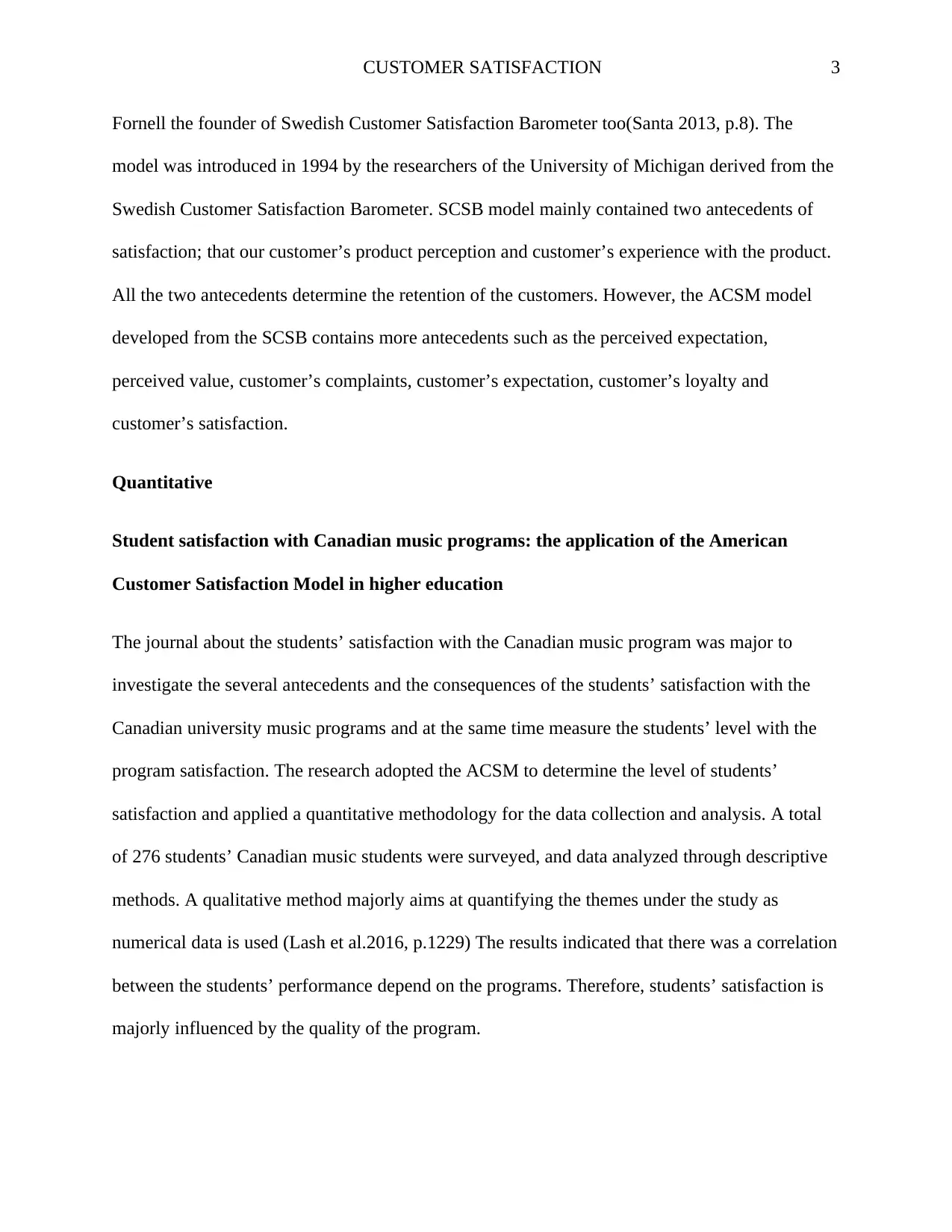
CUSTOMER SATISFACTION 3
Fornell the founder of Swedish Customer Satisfaction Barometer too(Santa 2013, p.8). The
model was introduced in 1994 by the researchers of the University of Michigan derived from the
Swedish Customer Satisfaction Barometer. SCSB model mainly contained two antecedents of
satisfaction; that our customer’s product perception and customer’s experience with the product.
All the two antecedents determine the retention of the customers. However, the ACSM model
developed from the SCSB contains more antecedents such as the perceived expectation,
perceived value, customer’s complaints, customer’s expectation, customer’s loyalty and
customer’s satisfaction.
Quantitative
Student satisfaction with Canadian music programs: the application of the American
Customer Satisfaction Model in higher education
The journal about the students’ satisfaction with the Canadian music program was major to
investigate the several antecedents and the consequences of the students’ satisfaction with the
Canadian university music programs and at the same time measure the students’ level with the
program satisfaction. The research adopted the ACSM to determine the level of students’
satisfaction and applied a quantitative methodology for the data collection and analysis. A total
of 276 students’ Canadian music students were surveyed, and data analyzed through descriptive
methods. A qualitative method majorly aims at quantifying the themes under the study as
numerical data is used (Lash et al.2016, p.1229) The results indicated that there was a correlation
between the students’ performance depend on the programs. Therefore, students’ satisfaction is
majorly influenced by the quality of the program.
Fornell the founder of Swedish Customer Satisfaction Barometer too(Santa 2013, p.8). The
model was introduced in 1994 by the researchers of the University of Michigan derived from the
Swedish Customer Satisfaction Barometer. SCSB model mainly contained two antecedents of
satisfaction; that our customer’s product perception and customer’s experience with the product.
All the two antecedents determine the retention of the customers. However, the ACSM model
developed from the SCSB contains more antecedents such as the perceived expectation,
perceived value, customer’s complaints, customer’s expectation, customer’s loyalty and
customer’s satisfaction.
Quantitative
Student satisfaction with Canadian music programs: the application of the American
Customer Satisfaction Model in higher education
The journal about the students’ satisfaction with the Canadian music program was major to
investigate the several antecedents and the consequences of the students’ satisfaction with the
Canadian university music programs and at the same time measure the students’ level with the
program satisfaction. The research adopted the ACSM to determine the level of students’
satisfaction and applied a quantitative methodology for the data collection and analysis. A total
of 276 students’ Canadian music students were surveyed, and data analyzed through descriptive
methods. A qualitative method majorly aims at quantifying the themes under the study as
numerical data is used (Lash et al.2016, p.1229) The results indicated that there was a correlation
between the students’ performance depend on the programs. Therefore, students’ satisfaction is
majorly influenced by the quality of the program.
⊘ This is a preview!⊘
Do you want full access?
Subscribe today to unlock all pages.

Trusted by 1+ million students worldwide
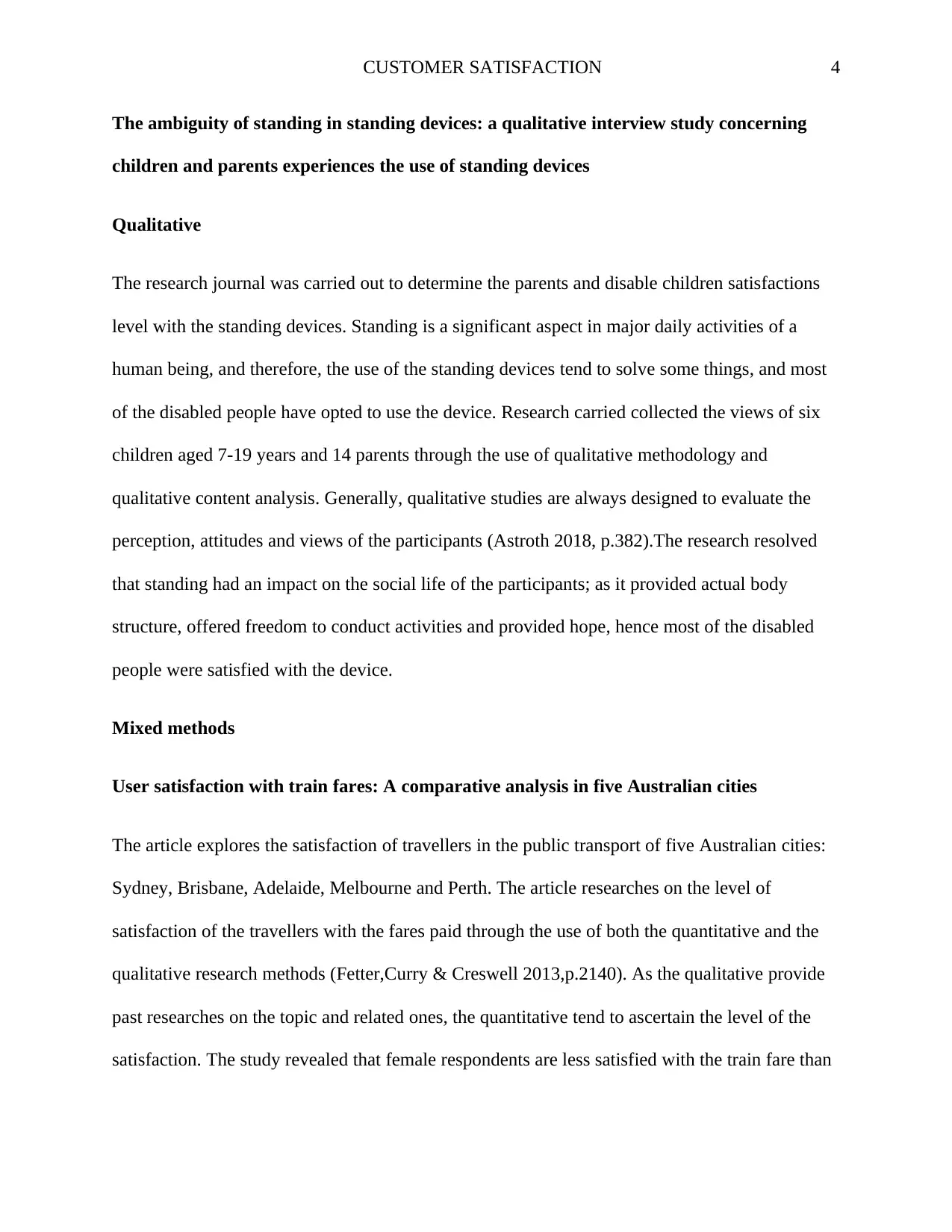
CUSTOMER SATISFACTION 4
The ambiguity of standing in standing devices: a qualitative interview study concerning
children and parents experiences the use of standing devices
Qualitative
The research journal was carried out to determine the parents and disable children satisfactions
level with the standing devices. Standing is a significant aspect in major daily activities of a
human being, and therefore, the use of the standing devices tend to solve some things, and most
of the disabled people have opted to use the device. Research carried collected the views of six
children aged 7-19 years and 14 parents through the use of qualitative methodology and
qualitative content analysis. Generally, qualitative studies are always designed to evaluate the
perception, attitudes and views of the participants (Astroth 2018, p.382).The research resolved
that standing had an impact on the social life of the participants; as it provided actual body
structure, offered freedom to conduct activities and provided hope, hence most of the disabled
people were satisfied with the device.
Mixed methods
User satisfaction with train fares: A comparative analysis in five Australian cities
The article explores the satisfaction of travellers in the public transport of five Australian cities:
Sydney, Brisbane, Adelaide, Melbourne and Perth. The article researches on the level of
satisfaction of the travellers with the fares paid through the use of both the quantitative and the
qualitative research methods (Fetter,Curry & Creswell 2013,p.2140). As the qualitative provide
past researches on the topic and related ones, the quantitative tend to ascertain the level of the
satisfaction. The study revealed that female respondents are less satisfied with the train fare than
The ambiguity of standing in standing devices: a qualitative interview study concerning
children and parents experiences the use of standing devices
Qualitative
The research journal was carried out to determine the parents and disable children satisfactions
level with the standing devices. Standing is a significant aspect in major daily activities of a
human being, and therefore, the use of the standing devices tend to solve some things, and most
of the disabled people have opted to use the device. Research carried collected the views of six
children aged 7-19 years and 14 parents through the use of qualitative methodology and
qualitative content analysis. Generally, qualitative studies are always designed to evaluate the
perception, attitudes and views of the participants (Astroth 2018, p.382).The research resolved
that standing had an impact on the social life of the participants; as it provided actual body
structure, offered freedom to conduct activities and provided hope, hence most of the disabled
people were satisfied with the device.
Mixed methods
User satisfaction with train fares: A comparative analysis in five Australian cities
The article explores the satisfaction of travellers in the public transport of five Australian cities:
Sydney, Brisbane, Adelaide, Melbourne and Perth. The article researches on the level of
satisfaction of the travellers with the fares paid through the use of both the quantitative and the
qualitative research methods (Fetter,Curry & Creswell 2013,p.2140). As the qualitative provide
past researches on the topic and related ones, the quantitative tend to ascertain the level of the
satisfaction. The study revealed that female respondents are less satisfied with the train fare than
Paraphrase This Document
Need a fresh take? Get an instant paraphrase of this document with our AI Paraphraser
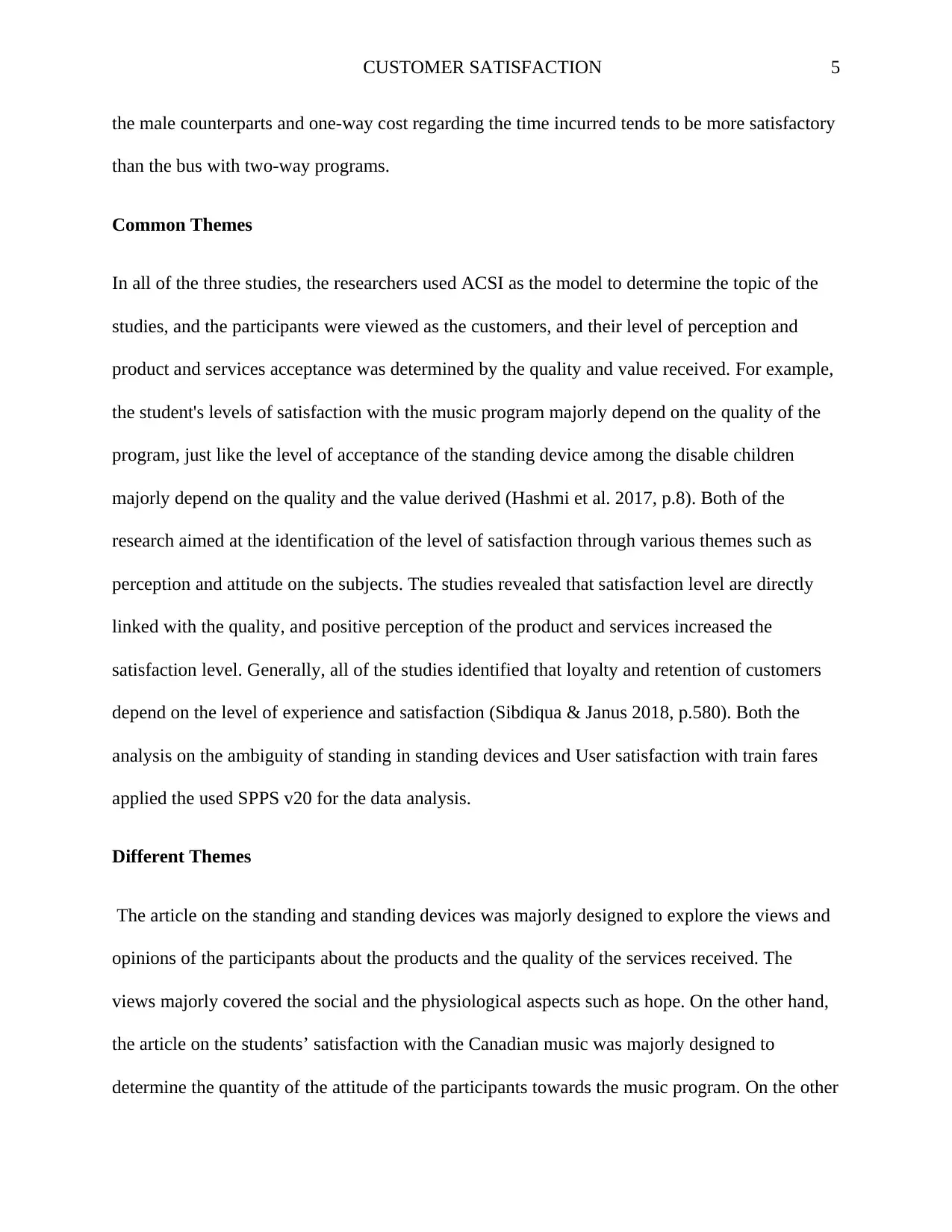
CUSTOMER SATISFACTION 5
the male counterparts and one-way cost regarding the time incurred tends to be more satisfactory
than the bus with two-way programs.
Common Themes
In all of the three studies, the researchers used ACSI as the model to determine the topic of the
studies, and the participants were viewed as the customers, and their level of perception and
product and services acceptance was determined by the quality and value received. For example,
the student's levels of satisfaction with the music program majorly depend on the quality of the
program, just like the level of acceptance of the standing device among the disable children
majorly depend on the quality and the value derived (Hashmi et al. 2017, p.8). Both of the
research aimed at the identification of the level of satisfaction through various themes such as
perception and attitude on the subjects. The studies revealed that satisfaction level are directly
linked with the quality, and positive perception of the product and services increased the
satisfaction level. Generally, all of the studies identified that loyalty and retention of customers
depend on the level of experience and satisfaction (Sibdiqua & Janus 2018, p.580). Both the
analysis on the ambiguity of standing in standing devices and User satisfaction with train fares
applied the used SPPS v20 for the data analysis.
Different Themes
The article on the standing and standing devices was majorly designed to explore the views and
opinions of the participants about the products and the quality of the services received. The
views majorly covered the social and the physiological aspects such as hope. On the other hand,
the article on the students’ satisfaction with the Canadian music was majorly designed to
determine the quantity of the attitude of the participants towards the music program. On the other
the male counterparts and one-way cost regarding the time incurred tends to be more satisfactory
than the bus with two-way programs.
Common Themes
In all of the three studies, the researchers used ACSI as the model to determine the topic of the
studies, and the participants were viewed as the customers, and their level of perception and
product and services acceptance was determined by the quality and value received. For example,
the student's levels of satisfaction with the music program majorly depend on the quality of the
program, just like the level of acceptance of the standing device among the disable children
majorly depend on the quality and the value derived (Hashmi et al. 2017, p.8). Both of the
research aimed at the identification of the level of satisfaction through various themes such as
perception and attitude on the subjects. The studies revealed that satisfaction level are directly
linked with the quality, and positive perception of the product and services increased the
satisfaction level. Generally, all of the studies identified that loyalty and retention of customers
depend on the level of experience and satisfaction (Sibdiqua & Janus 2018, p.580). Both the
analysis on the ambiguity of standing in standing devices and User satisfaction with train fares
applied the used SPPS v20 for the data analysis.
Different Themes
The article on the standing and standing devices was majorly designed to explore the views and
opinions of the participants about the products and the quality of the services received. The
views majorly covered the social and the physiological aspects such as hope. On the other hand,
the article on the students’ satisfaction with the Canadian music was majorly designed to
determine the quantity of the attitude of the participants towards the music program. On the other
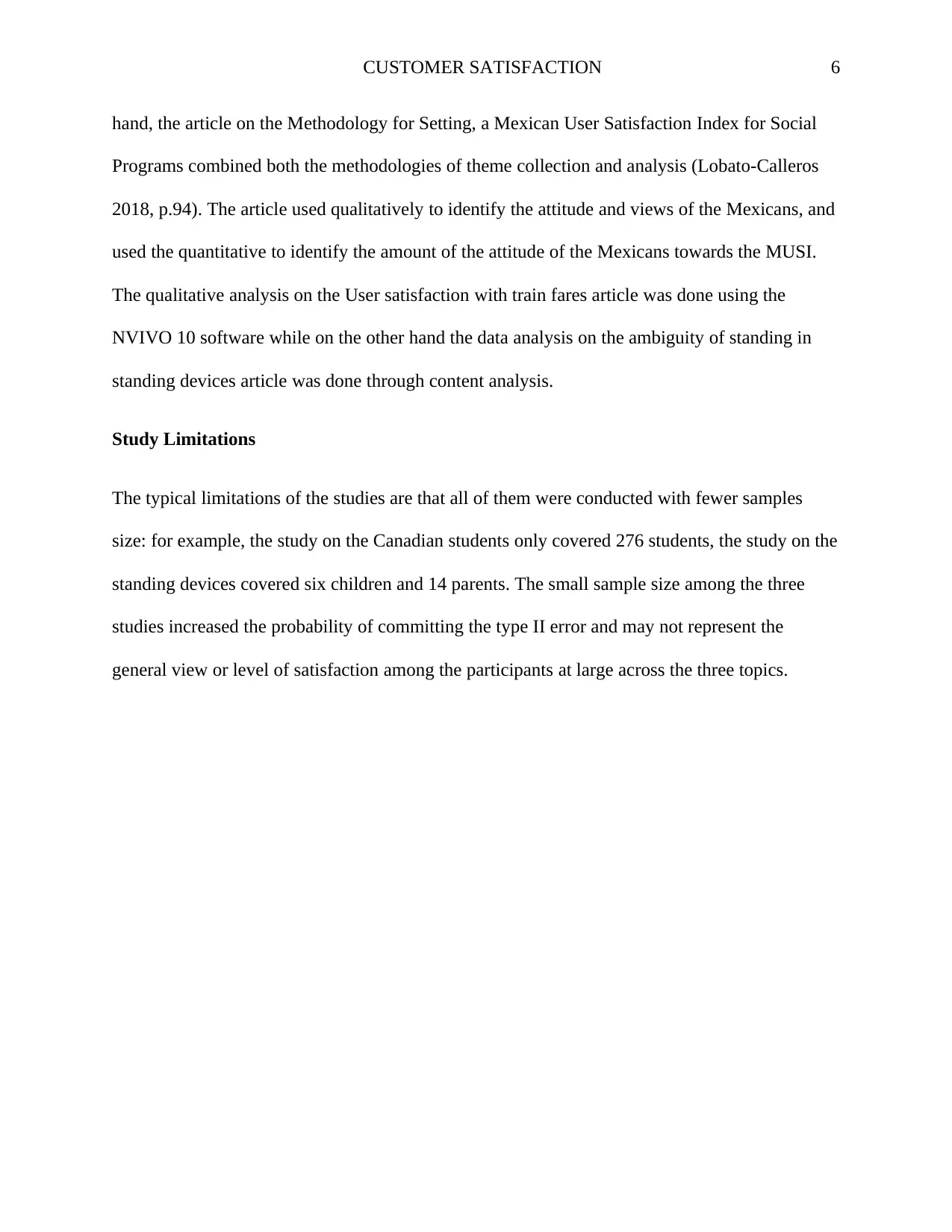
CUSTOMER SATISFACTION 6
hand, the article on the Methodology for Setting, a Mexican User Satisfaction Index for Social
Programs combined both the methodologies of theme collection and analysis (Lobato-Calleros
2018, p.94). The article used qualitatively to identify the attitude and views of the Mexicans, and
used the quantitative to identify the amount of the attitude of the Mexicans towards the MUSI.
The qualitative analysis on the User satisfaction with train fares article was done using the
NVIVO 10 software while on the other hand the data analysis on the ambiguity of standing in
standing devices article was done through content analysis.
Study Limitations
The typical limitations of the studies are that all of them were conducted with fewer samples
size: for example, the study on the Canadian students only covered 276 students, the study on the
standing devices covered six children and 14 parents. The small sample size among the three
studies increased the probability of committing the type II error and may not represent the
general view or level of satisfaction among the participants at large across the three topics.
hand, the article on the Methodology for Setting, a Mexican User Satisfaction Index for Social
Programs combined both the methodologies of theme collection and analysis (Lobato-Calleros
2018, p.94). The article used qualitatively to identify the attitude and views of the Mexicans, and
used the quantitative to identify the amount of the attitude of the Mexicans towards the MUSI.
The qualitative analysis on the User satisfaction with train fares article was done using the
NVIVO 10 software while on the other hand the data analysis on the ambiguity of standing in
standing devices article was done through content analysis.
Study Limitations
The typical limitations of the studies are that all of them were conducted with fewer samples
size: for example, the study on the Canadian students only covered 276 students, the study on the
standing devices covered six children and 14 parents. The small sample size among the three
studies increased the probability of committing the type II error and may not represent the
general view or level of satisfaction among the participants at large across the three topics.
⊘ This is a preview!⊘
Do you want full access?
Subscribe today to unlock all pages.

Trusted by 1+ million students worldwide
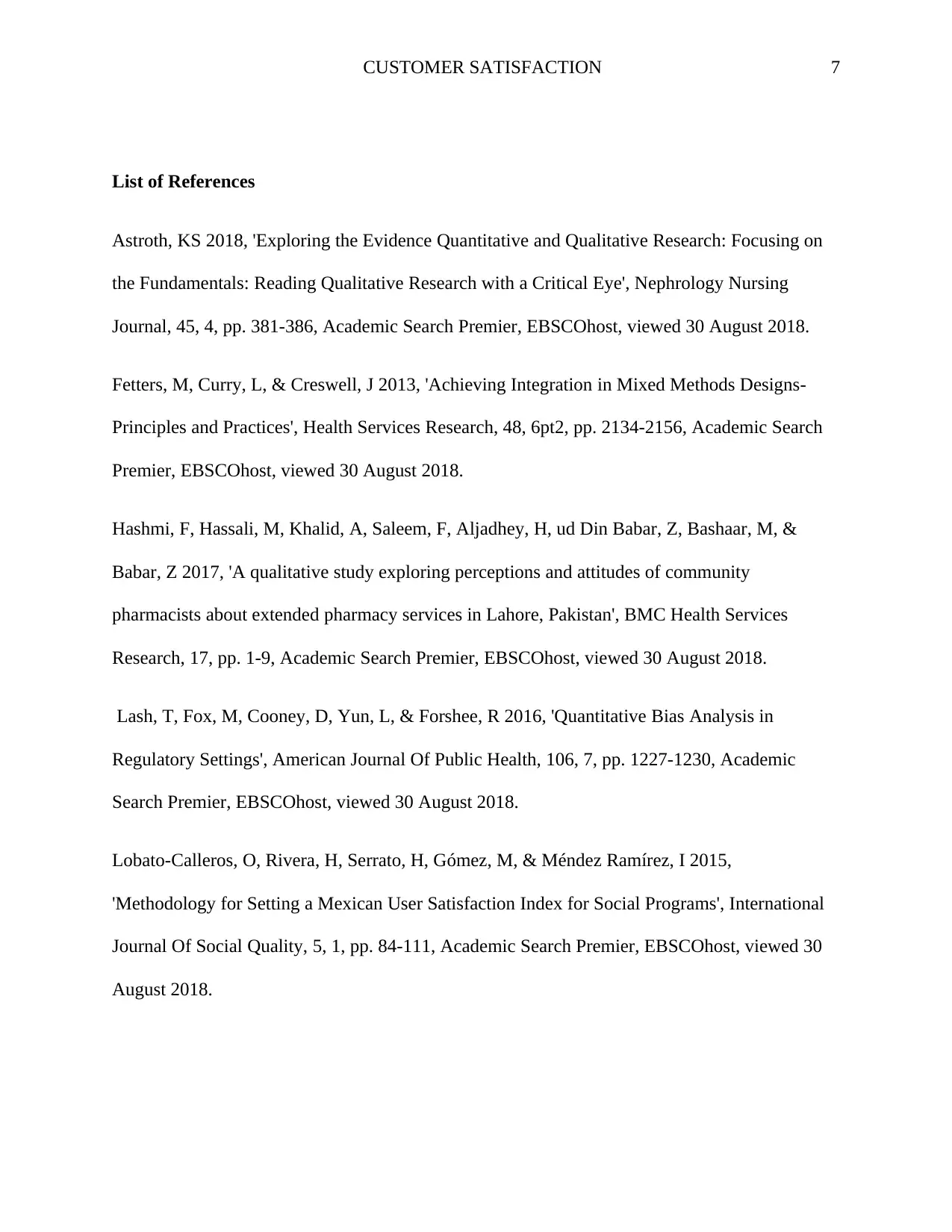
CUSTOMER SATISFACTION 7
List of References
Astroth, KS 2018, 'Exploring the Evidence Quantitative and Qualitative Research: Focusing on
the Fundamentals: Reading Qualitative Research with a Critical Eye', Nephrology Nursing
Journal, 45, 4, pp. 381-386, Academic Search Premier, EBSCOhost, viewed 30 August 2018.
Fetters, M, Curry, L, & Creswell, J 2013, 'Achieving Integration in Mixed Methods Designs-
Principles and Practices', Health Services Research, 48, 6pt2, pp. 2134-2156, Academic Search
Premier, EBSCOhost, viewed 30 August 2018.
Hashmi, F, Hassali, M, Khalid, A, Saleem, F, Aljadhey, H, ud Din Babar, Z, Bashaar, M, &
Babar, Z 2017, 'A qualitative study exploring perceptions and attitudes of community
pharmacists about extended pharmacy services in Lahore, Pakistan', BMC Health Services
Research, 17, pp. 1-9, Academic Search Premier, EBSCOhost, viewed 30 August 2018.
Lash, T, Fox, M, Cooney, D, Yun, L, & Forshee, R 2016, 'Quantitative Bias Analysis in
Regulatory Settings', American Journal Of Public Health, 106, 7, pp. 1227-1230, Academic
Search Premier, EBSCOhost, viewed 30 August 2018.
Lobato-Calleros, O, Rivera, H, Serrato, H, Gómez, M, & Méndez Ramírez, I 2015,
'Methodology for Setting a Mexican User Satisfaction Index for Social Programs', International
Journal Of Social Quality, 5, 1, pp. 84-111, Academic Search Premier, EBSCOhost, viewed 30
August 2018.
List of References
Astroth, KS 2018, 'Exploring the Evidence Quantitative and Qualitative Research: Focusing on
the Fundamentals: Reading Qualitative Research with a Critical Eye', Nephrology Nursing
Journal, 45, 4, pp. 381-386, Academic Search Premier, EBSCOhost, viewed 30 August 2018.
Fetters, M, Curry, L, & Creswell, J 2013, 'Achieving Integration in Mixed Methods Designs-
Principles and Practices', Health Services Research, 48, 6pt2, pp. 2134-2156, Academic Search
Premier, EBSCOhost, viewed 30 August 2018.
Hashmi, F, Hassali, M, Khalid, A, Saleem, F, Aljadhey, H, ud Din Babar, Z, Bashaar, M, &
Babar, Z 2017, 'A qualitative study exploring perceptions and attitudes of community
pharmacists about extended pharmacy services in Lahore, Pakistan', BMC Health Services
Research, 17, pp. 1-9, Academic Search Premier, EBSCOhost, viewed 30 August 2018.
Lash, T, Fox, M, Cooney, D, Yun, L, & Forshee, R 2016, 'Quantitative Bias Analysis in
Regulatory Settings', American Journal Of Public Health, 106, 7, pp. 1227-1230, Academic
Search Premier, EBSCOhost, viewed 30 August 2018.
Lobato-Calleros, O, Rivera, H, Serrato, H, Gómez, M, & Méndez Ramírez, I 2015,
'Methodology for Setting a Mexican User Satisfaction Index for Social Programs', International
Journal Of Social Quality, 5, 1, pp. 84-111, Academic Search Premier, EBSCOhost, viewed 30
August 2018.
Paraphrase This Document
Need a fresh take? Get an instant paraphrase of this document with our AI Paraphraser
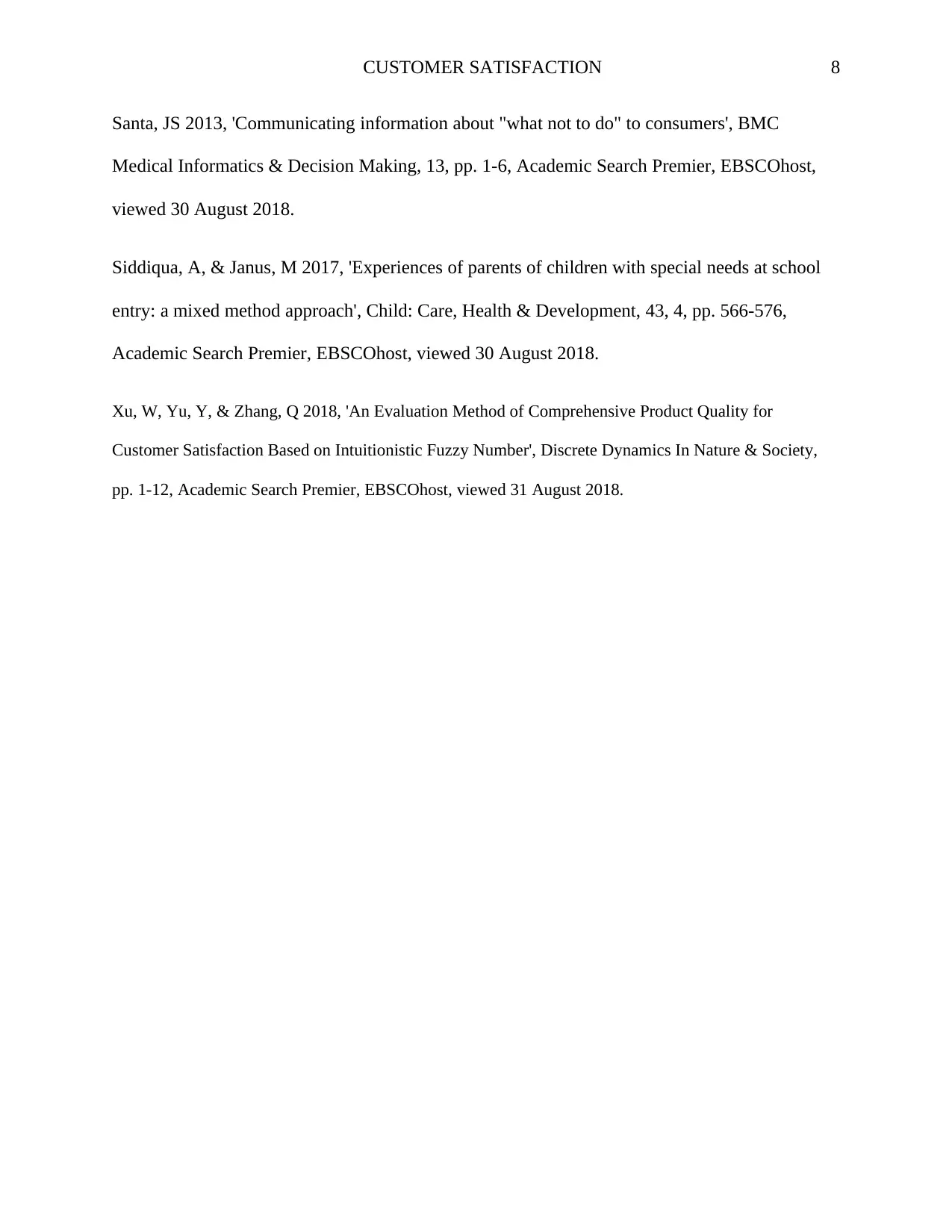
CUSTOMER SATISFACTION 8
Santa, JS 2013, 'Communicating information about "what not to do" to consumers', BMC
Medical Informatics & Decision Making, 13, pp. 1-6, Academic Search Premier, EBSCOhost,
viewed 30 August 2018.
Siddiqua, A, & Janus, M 2017, 'Experiences of parents of children with special needs at school
entry: a mixed method approach', Child: Care, Health & Development, 43, 4, pp. 566-576,
Academic Search Premier, EBSCOhost, viewed 30 August 2018.
Xu, W, Yu, Y, & Zhang, Q 2018, 'An Evaluation Method of Comprehensive Product Quality for
Customer Satisfaction Based on Intuitionistic Fuzzy Number', Discrete Dynamics In Nature & Society,
pp. 1-12, Academic Search Premier, EBSCOhost, viewed 31 August 2018.
Santa, JS 2013, 'Communicating information about "what not to do" to consumers', BMC
Medical Informatics & Decision Making, 13, pp. 1-6, Academic Search Premier, EBSCOhost,
viewed 30 August 2018.
Siddiqua, A, & Janus, M 2017, 'Experiences of parents of children with special needs at school
entry: a mixed method approach', Child: Care, Health & Development, 43, 4, pp. 566-576,
Academic Search Premier, EBSCOhost, viewed 30 August 2018.
Xu, W, Yu, Y, & Zhang, Q 2018, 'An Evaluation Method of Comprehensive Product Quality for
Customer Satisfaction Based on Intuitionistic Fuzzy Number', Discrete Dynamics In Nature & Society,
pp. 1-12, Academic Search Premier, EBSCOhost, viewed 31 August 2018.
1 out of 8
Your All-in-One AI-Powered Toolkit for Academic Success.
+13062052269
info@desklib.com
Available 24*7 on WhatsApp / Email
![[object Object]](/_next/static/media/star-bottom.7253800d.svg)
Unlock your academic potential
Copyright © 2020–2025 A2Z Services. All Rights Reserved. Developed and managed by ZUCOL.